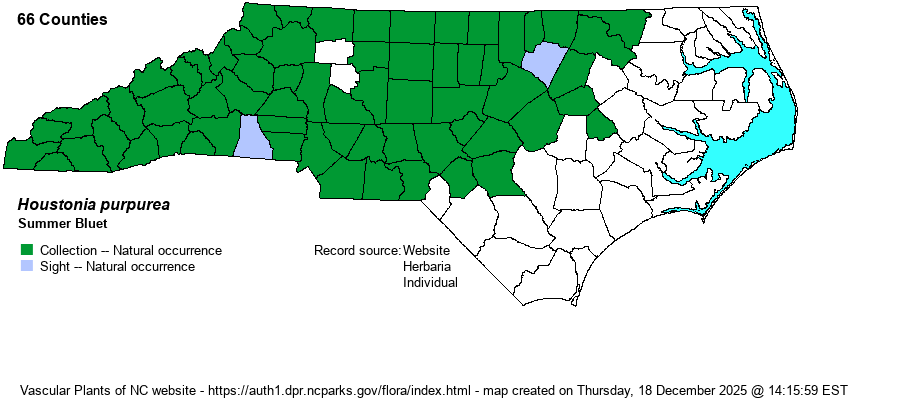| Author | L. | |
| Distribution | Throughout the Mountains and Piedmont; in the Coastal Plain found mainly in the Sandhills region in the southwestern part of the province.
This is an essentially Eastern species, ranging from southern PA and MO south to northern FL and eastern TX, being found in most counties within this range. | |
| Abundance | Common and quite widespread in the range in NC, seen almost daily in suitable habitat. Essentially absent in nearly all of the Coastal Plain other than the Sandhills. | |
| Habitat | This species has a great range of upland habitats, usually in partial shade. It grows in open dry to mesic woods, wooded borders, forest trailsides, roadbanks, around outcrops, and in small opening in various forest types. | |
| Phenology | Blooms from May to July, and fruits in July and August. | |
| Identification | This is a very familiar species and is the main white-flowered Houstonia seen in the state. It has elliptical basal leaves that are usually gone by the time of flowering, though they can at times be present. The stems are 4-angled, slightly winged, generally about 6-8 inches tall, typically a few stems from a common base. The several pairs of opposite leaves are larger for a Houstonia species, being widely ovate to almost triangular, sessile, about 1-1.5 inches long and about 2/3-inch wide near the base. The leaves are 3-nerved, instead of 1-nerved in most other white-flowered Houstonia species. The flowers are in terminal cymes like other similar species, being white or lavender-white, about 1/4-1/3-inch long and wide at the 4 spreading petals. Other similar species have much more slender stem leaves, generally parallel-sided. The very rare and endangered H. montana has lavender-purple flowers, longer than those of this species, and the stem is smooth between leaf nodes. H. purpurea has somewhat pubescent stems between nodes. H. montana is restricted to high elevation and usually exposed rocky summits, though H. purpurea might possibly occur nearby. | |
| Taxonomic Comments | Many references have the species split into several varieties, but Weakley (2018) has them (including H. lanceolata) as good species.
| |
| Other Common Name(s) | Purple Bluet, Mountain Bluet, Woodland Bluet, Large Houstonia, Venus' Pride. Purple Bluet is often used, but the flowers of this species are usually white. | |
| State Rank | S5 | |
| Global Rank | G5 | |
| State Status | | |
| US Status | | |
| USACE-agcp | | |
| USACE-emp | | |

